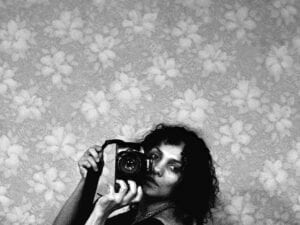Pao Houa Her (b. 1982) is a Hmong American artist whose practice engages with the legacies of documentary, landscape and still-life in relation to Hmong diasporic communities. Her was born in Laos, where she lived until the age of three, before fleeing with her family to Saint Paul, Minnesota. The artist remembers the passage from Laos to refugee camps in Thailand, which included crossing the Mekong River on her mother’s back. During this journey, she was given opium as a baby to soothe her crying. In her latest book, My Grandfather Turned into a Tiger…, published by Aperture, the artist builds on her experience of diaspora and displacement. The photobook accompanies a solo exhibition at Baxter Street, Camera Club of New York, showing work made from 2016-2022. Her draws from traditions of portraiture, focusing on Hmong culture and Southeast Asian experiences, as well as documentary and still life photography.

This is a book that explores topics of belonging, loss, memory and identity. Her navigates what it means to be both connected to, and removed from a space, expanding on her memory of leaving Laos as a child. She looks to her family and ancestry for inspiration, explaining, “This body of work really came out of a story that was told to me by a great aunt that was dying of cancer. She told me this tale about how my grandfather was asked to go fight in the Vietnam War in the early 60s, and not long after he went, he died. We’re not sure how he died, but surely after, a tiger showed up at my grandmothers home, and stayed with her until she asked it to leave. People in the village believed the tiger was my grandfather.” Half of the work was shot in Laos, and the other half in the US – demonstrating the complex realities of diasporic identity. In an interview later on in the book Her notes, “Ultimately it’s about the power of stories to guide us through difficult circumstances. Sometimes the symbols we believe in – can actually save us, give us meaning.”


The monograph brings together four of Her’s major series. Attention (2012-2014) is dedicated to formal portraits of older Hmong men who served in the Vietnam War. Whilst Hmong men, including Her’s father, were recruited by the US government to fight Laotian communists, the soldiers were never officially recognised as veterans. Despite their sacrifices on the behalf of the US, they are prohibited from being buried in national or state veteran cemeteries, nor do they receive medical care or pensions. Her’s work is a testament to the existence of these men. She recreates 19th-century military portraiture, staging subjects in uniforms. They wear medals as a way of combatting erasure, demanding a viewer’s respect. Elsewhere, in My Mother’s Flowers (2016), Her combines portraits of Hmong women with formal still lifes of flowers. Floral studio shots sit alongside documentary prints in a series that explores concepts of desire within the native Hmong community. Finally, Mount Shasta (2021-2022) features a series of landscape photographs from the region around the famous volcano. Today, it stands as a popular site of marijuana cultivation by Hmong immigrants in California. Here, we’re given the story of a contemporary America, notably one that is tied together by crucial conditions of agriculture, labour and migration.

This is a collection guided by stories, that in critic Godfre Leung’s words, “holds a kaleidoscope up to photographic portraiture.” Kong Pheng Pha, Assistant Professor of Gender and Women’s and Asian American Studies at the University of Wisconsin-Madison, continues, “Hmong’s photographic repertoire draws on the fragmented temporalities and uneven geographies of worlds past to perform a visual narrative of how these disconnected histories unfold in the present. Photography remixes with oral history.” Black and white pastoral images sit alongside portraits with digitally manipulated backgrounds, blurring real and dreamlike worlds. Her imagines life before leaving Laos, producing a monograph that is reminiscent of contemporaries Leonard Suryajaya (b. 1988) and Widline Cadet (b. 1992). We’re not given a complete history of Laos or Her’s family – this is not the point of the book. Instead, however we’re shown the centrality of Hmong identity, as it weaves through Her’s narrative, connecting past, present, and future. Through the artist’s lens, we’re invited to explore an intricate tapestry of cultural and personal experience, where each image serves as a portal to understanding, reflection, and connection.
My Grandfather Turned Into a Tiger… | Aperture
Words: Chloe Elliott
Image Credits:
Pao Houa Her, Untitled (opium flower with pink fabric), 2019; from The Imaginative Landscape; from Pao Houa Her: My grandfather turned into a tiger … and other illusions (Aperture, 2024). © 2024 Pao Houa Her
Pao Houa Her, Jungle fire, 2017; from My grandfather turned into a tiger; from Pao Houa Her: My grandfather turned into a tiger … and other illusions (Aperture, 2024). © 2024 Pao Houa Her
Pao Houa Her, Untitled (black and white dried poppy), 2019, from The Imaginative Landscape; from Pao Houa Her: My grandfather turned into a tiger … and other illusions (Aperture, 2024). © 2024 Pao Houa Her
Pao Houa Her, Prince Charming, 2016, from My grandfather turned into a tiger; from Pao Houa Her: My grandfather turned into a tiger … and other illusions (Aperture, 2024). © 2024 Pao Houa Her





